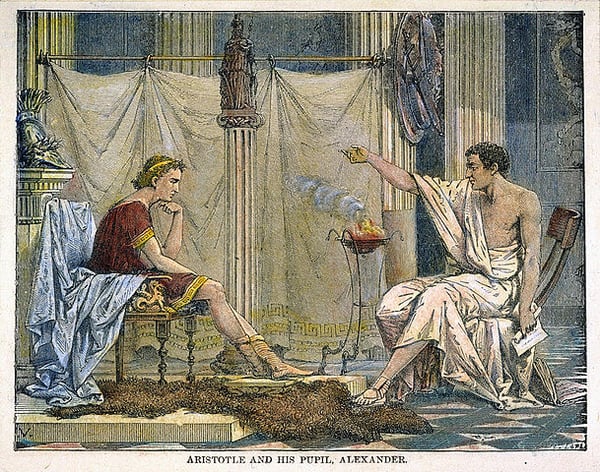How Can Kairos Be Used As A Reading Strategy
Ethos, pathos, logos, and kairos all stem from rhetoric—that is, speaking and writing effectively. You might detect the concepts in courses on rhetoric, psychology, English, or in just most whatsoever other field! The concepts of ethos, pathos, logos, and kairos are also called the modes of persuasion, ethical strategies, or rhetorical appeals. They accept a lot of different applications ranging from everyday interactions with others to big political speeches to effective advertising. Read on to learn about what the modes of persuasion are, how they're used, and how to identify them! Every bit you might have guessed from the audio of the words, ethos, pathos, logos, and kairos go all the way back to aboriginal Hellenic republic. The concepts were introduced in Aristotle'south Rhetoric, a treatise on persuasion that approached rhetoric as an art, in the fourth century BCE. Rhetoric was primarily concerned with ethos, pathos, and logos, but kairos, or the idea of using your words at the correct time, was besides an important characteristic of Aristotle'south teachings. However, kairos was particularly interesting to the Sophists, a group of intellectuals who fabricated their living teaching a variety of subjects. The Sophists stressed the importance of structuring rhetoric effectually the platonic fourth dimension and place. Together, all iv concepts accept become the modes of persuasion, though we typically focus on ethos, pathos, and logos. Though y'all may not have heard the term before, 'ethos' is a common concept. You can think of it as an appeal to dominance or grapheme—persuasive techniques using ethos will attempt to persuade you based on the speaker'southward social standing or knowledge. The give-and-take ethos even comes from the Greek word for graphic symbol. An ethos-based statement will include a statement that makes use of the speaker or writer's position and knowledge. For example, hearing the phrase, "Every bit a doctor, I believe," before an argument about concrete health is more likely to sway you lot than hearing, "Every bit a second-form teacher, I believe." Likewise, celebrity endorsements can be incredibly effective in persuading people to do things. Many viewers aspire to be similar their favorite celebrities, and then when they appear in advertisements, they're more likely to purchase whatever they're selling to be more like them. The same is true of social media influencers, whose partnerships with brands tin have huge fiscal benefits for marketers. In addition to authority figures and celebrities, according to Aristotle, nosotros're more likely to trust people who we perceive as having good sense, proficient morals, and goodwill—in other words, we trust people who are rational, fair, and kind. You don't have to exist famous to employ ethos effectively; y'all just need whoever you're persuading to perceive y'all as rational, moral, and kind. Pathos, which comes from the Greek give-and-take for suffering or experience, is rhetoric that appeals to emotion. The emotion appealed to tin can exist a positive or negative i, but whatever information technology is, it should make people feel strongly equally a means of getting them to agree or disagree. For example, imagine someone asks you to donate to a cause, such equally saving rainforests. If they just ask yous to donate, y'all may or may non desire to, depending on your previous views. Merely if they take the time to tell you a story nearly how many animals become extinct because of deforestation, or fifty-fifty about how their fundraising efforts have improved conditions in the rainforests, you may exist more likely to donate considering you're emotionally involved. But desolation isn't just about creating emotion; it can as well exist nigh counteracting it. For example, imagine a teacher speaking to a group of aroused children. The children are annoyed that they have to practice schoolwork when they'd rather be outside. The teacher could admonish them for misbehaving, or, with rhetoric, he could change their minds. Suppose that, instead of punishing them, the teacher instead tries to inspire calmness in them by putting on some soothing music and speaking in a more hushed vocalisation. He could also endeavour reminding them that if they get to work, the time will pass quicker and they'll be able to go outside to play. Aristotle outlines emotional dichotomies in Rhetoric. If an audition is experiencing one emotion and information technology's necessary to your argument that they experience another, you can weigh the unwanted emotion with the desired one. The dichotomies, expanded upon subsequently Aristotle, are: Note that these can work in either management; it's non just about swaying an audience from a negative emotion to a positive ane. However, changing an audience's emotion based on false or misleading information is often seen as manipulation rather than persuasion. Getting into the hows and whys requires a dive into the ethics of rhetoric, but suffice to say that when y'all effort to deceive an audience, that is manipulation. If yous really want to become an audience fired up nearly something, yous can inspire righteous anger, which may or may not be manipulation. If somebody is offended that you've asked them for something, you can endeavour making them feel sorry for yous past turning indignation into pity—that'south manipulation. Logos comes from a Greek word of multiple meanings, including "ground," "speech," and "reason." In rhetoric, information technology specifically refers to having a sense of logic to your persuasion; logos-based rhetoric is founded in logic and reason rather than emotion, potency, or personality. A logic-based argument appeals to a person'south sense of reason—expert logos-based rhetoric will persuade people because the argument is well-reasoned and based in fact. In that location are two common approaches to logos: deductive and inductive arguments. Deductive arguments build on statements to reach a conclusion—in upshot, the conclusion is reached in reverse. A common method is to propose multiple true statements which are combined to reach a conclusion, such as the classic method of proving that Socrates is mortal. All men are mortal, and Socrates is a man, therefore Socrates must exist mortal. That's non really a case that needs to be argued, just nosotros can apply the same framework to other arguments as well. For case, nosotros need free energy to live. Food gives the body energy. Therefore, we need food to live. All of this is based on things we tin prove, and results in a conclusion that is true, not but theorized. Deductive reasoning works on the assumption that A = B, B = C, and then therefore A = C. But this also supposes that all the data is true, which is not always the case. Sometimes the conclusions you reach with deductive reasoning can exist valid, every bit in the reasoning makes sense, merely the conclusion may not be necessarily true. If we return to the Socrates argument, we could propose that: All men eat apples. Socrates is a man. Therefore, Socrates must consume apples. The problem is that we tin can't prove that all men eat apples—some do, some don't. Some might eat an apple in one case but never again. But based on our arguments, the conclusion that Socrates must eat apples is valid. A strong deductive argument for logos-based reasoning will be composed of provable facts that can accomplish a provable conclusion. However, a valid but not entirely audio statement can also exist constructive—but be wary of shifting from persuasion to manipulation! Another approach to logos-based rhetoric is inductive reasoning, which, unlike deductive reasoning, results in a probable argument rather than a definite i. That doesn't mean that it is less effective—many scientific concepts we accept equally truth are inductive theories simply considering we cannot travel back in fourth dimension and prove them—but rather that inductive reasoning is based on eliminating the impossible and ending in an argument that is based in sound logic and fact, but that may not necessarily be provable. For example, all people with a cough have a cold. Kelly has a cough. Therefore, Kelly probable has a cold. Our determination is likely, only not absolute. It's possible that Kelly doesn't have a common cold—not considering she doesn't have a cough, just considering in that location are other possible causes, such every bit having allergies or having just breathed in some dust. The conclusion that she has a cold is likely based on information, but not accented. Another example would be that Kelly picks her olfactory organ. Kelly is a woman, therefore all women must pick their nose. Inductive reasoning is based on generalizations. The first example, in which Kelly likely has a cold, makes sense considering it's based on something provable—that a sampling of people who have a coughing have colds—and followed upwardly with a likely decision. In the second example, this is a less sensible determination because information technology's based on extrapolation from a single reference betoken. If nosotros reverse the claim and say that all women pick their noses, and Kelly is a adult female, therefore Kelly must pick her nose, that would be more sound logic. However not necessarily true—not all women pick their noses—but a more sound instance of anterior reasoning. Inductive reasoning can even so be incredibly effective in persuasion, provided that your information is well-reasoned. Inductive reasoning creates a hypothesis that can be tested; its conclusion is not necessarily true, but can be examined. As always, be wary of venturing into manipulation, which is more likely to be based on erroneous or misleading facts. Kairos is the Greek discussion for the opportune moment, which is precisely what information technology means in rhetoric. According to this principle, the fourth dimension in which an argument is deployed is as important as the argument itself. An statement at the wrong time or to the wrong audience volition be wasted; to exist constructive, you must also consider when you are speaking and to whom. In outcome, kairos means choosing the right rhetorical device to match the audience and infinite in which y'all're attempting to persuade. If you wanted to persuade people to become vegetarian, the heart of a hot dog-eating contest is probably not the right fourth dimension. Likewise, you lot're probably not going to persuade a room of data-driven scientists of something by appealing to desolation or ethos; logos is probably your best bet. In essence, kairos asks yous to consider the context and atmosphere of the argument you're making. How tin y'all deploy your statement ameliorate considering time and space? Should you wait, or is time of the essence? Every bit Aristotle famously said, "Everyone can go aroused—that is easy, but to be angry with the right person and to the correct caste and at the right fourth dimension and for the right purpose, and in the right way—that is not within everybody's power and is not piece of cake." The goal of kairos is to achieve exactly that. Effective use of kairos strengthens your persuasion ability by considering how people are already feeling based on context. How can you influence or counteract that? Or peradventure pathos isn't the right approach—maybe cold difficult facts, using logos, is more than suited. Kairos works in conjunction with the other modes of persuasion to strengthen your argument, so equally you're putting a persuasive slice together, consider how and when information technology'll be deployed! Agreement how the modes of persuasion piece of work can make y'all better at identifying and picking them out. Not only is a better agreement of them useful for composing your own arguments, just it's likewise benign when seeing other people's arguments. When you lot sympathize how ethos, desolation, logos, and kairos work, you're less susceptible to them. Advertising is one of the places nosotros see the modes of persuasion well-nigh oftentimes. Looking at each of these advertisements, yous can see how they use each mode of persuasion to convince audiences to convince an audience of something. Using celebrities is a classic case of ethos, which uses authority or recognition to convince an audience of something. In this case, celebrities similar Michelle Obama, Lin-Manuel Miranda, and Janelle Monáe discuss the importance of voting. It doesn't affair that they're not politicians or political scientists; audiences find them appealing and genuine. When they speak of the importance of voting, audiences listen considering they like what these figures take to say. If talented, famous people like this are taking the fourth dimension to vote, information technology must be of import! Historians or those well-versed in politics might brand different arguments most why audiences should vote, but in this example, the goal is to inspire people. When nosotros run into people nosotros adore doing things, we want to practise them too; hence the reason that ethos works and then well. ASPCA's commercials are some of the most infamous examples of pathos in advertising. Sarah McLachlan's "Angel" plays over footage of driveling animals in shelters, encouraging viewers to donate money to back up the organization. It'due south non difficult to sympathise why information technology works; both the vocal and the imagery are heartbreaking! You can't help but feel sad when you see it, and that sadness, when followed up by a prompt to donate, encourages you to take immediate activity.And these ads are effective—the campaign raised millions of dollars for ASPCA. By appealing to our emotions and making us feel sad, this advertising encourages us to deed. That's a classic use of ethos—it influences our feelings through the one-2 punch of sad music and imagery, encouraging us to perform the desired action. In some cases, emotion and authority aren't the correct tactic. Logos often appears in tech advertisements, such as this 1 for the iPhone XS and XR. Find how the advertizement focuses on product shots and technological terms. About audiences won't know what an A12 bionic neural engine is, but it sounds impressive. Also, that "12 MPf/1.8 wide-angle lens, with larger, deeper 1.4 micron pixels" is pretty meaningless to virtually people, but the numbers propose that this phone is something special considering it uses scientific-sounding linguistic communication. It doesn't matter whether audiences really understand what'due south being said or non. What matters is that they feel confident that the advertisement is selling them something they demand—in this case, impressive technological specifications that brand this phone an improvement over others. Kairos should ideally factor into all uses of the modes of persuasion, simply timeliness tin also be a big selling point. In this Christmas-themed Thou&Ms advertisement, the company uses timely sense of humour to forge a connexion between the holidays and Grand&Ms. Because these commercials have been running for such a long time, there's as well a nostalgic attachment to them. Just every bit people expect forward to new Budweiser advertisements during the Super Bowl, others look frontward to seeing M&Ms or the Coca-Cola polar deport during the holidays. Though this commercial doesn't go out of its way to tell you the benefits of Thou&Ms, it does forge a connection betwixt M&Ms and Christmas, encouraging people to purchase them around the holidays. Now that y'all've had some exposure to how ethos, desolation, logos, and kairos role and what they can do, yous can test your ability to recognize them using the images below! There are a few things to observe virtually this image: Can y'all figure out which way of persuasion this represents? The fact that the figure is anonymous tells us information technology's probably not ethos. While we might be influenced by a person who's in shape, in that location's not really an entreatment here based on the person—they're just an epitome to back up the ad. "DOMINATE" is a pretty loaded give-and-take, suggesting that this may accept elements of pathos. However, take a look at that statistic. Whether it'south true or non, a difficult statistic similar that suggests that this advertizement is using logos to appeal to viewers. You tin depict out an argument from at that place—75% of users lose weight within weeks. Yous're a user. Therefore, you lot will probable lose weight within weeks. What do y'all find virtually this epitome? What mode of persuasion is this? Again, we don't know who the model is, and perfume isn't going to make us look like her, then nosotros can count ethos out. The advertising seems pretty intent on making us wait at certain things—the woman'southward lips and breast in detail. What is it trying to brand us feel? "FORBIDDEN FRUIT" has a connotation of sensuality. Crimson is a color commonly associated with passion. When you combine the photo, the framing, the perfume proper noun, and the color, y'all get a strong sense of sex appeal from the advertizement. This makes information technology an instance of pathos—the ad is trying to brand us experience a certain mode. If we buy this perfume, maybe we would feel attractive, as well. How about this advertisement? Seeing a doctor might make you tempted to think the answer is logos, but there'southward no appeal to logic here. "No more than back pain," is a dainty promise, just in that location'southward no endeavour to entreatment to emotions, then it tin can't be desolation. What's important in this paradigm is the combination of the doctor in the epitome and the line "doctor recommended." This doctor might not be famous, but he does have say-so, making this an example of ethos. Our confidence in this treatment grows because we trust that a doctor understands how to address back pain. What mode of persuasion is this?Think almost: She does look stylish and the ad mentions stylists, and then it's possible that this is ethos. There are no statistics or arguments beingness made, so the answer probably isn't logos. Desolation is possible, but despite having a heavily fabricated-up model, this advertizement is far less well-nigh sexual practice appeal than the previous ane. Simply the text mentions a specific holiday—New year's—suggesting that this is kairos. Kairos can, and often should, be combined with all the modes of persuasion to be even more constructive. In this case, the model'southward appearance could advise either ethos or desolation in addition to kairos. The message hither is that you should act now, at the beginning of the twelvemonth, to have advantage of the bargain and to start the year off with a new style, much like the one the model is sporting. Now that yous know the difference between all the modes of persuasion, you'll have a much easier time identifying them. If you encounter trouble, y'all can always enquire questions virtually what you're seeing, hearing, or reading to understand what manner of persuasion information technology's using. If the argument is based on a specific mean solar day or context, such equally Valentine's Day or highly-seasoned only to a select group of people, such as people with dogs, it'south more likely to exist kairos. Celebrities are often a dead giveaway that an argument is using ethos. But say-so figures, such as doctors, dentists, or politicians, tin also be used to appeal to ethos. Fifty-fifty regular, everyday people tin work, specially when combined with pathos, to entreatment to you based on a mutual connection you take. Statistics are a huge clue that an argument is using logos. But logos can also just be a logical argument, such as that if plants need h2o, and information technology's hard to call back to h2o them, you should buy an automated plant waterer. It makes perfect sense, making you more probable to buy information technology, rather than irresolute your habits to remember to water your plants more than frequently. If an argument tries to change your emotions, whether by making you pitiful, happy, angry, or something else entirely, it'south a skilful indicator that information technology'south using pathos. Sex activity entreatment is one of the biggest examples of pathos in advert, appearing everywhere from makeup ads to car commercials to hamburger advertisements. Need help understanding the historical context forThe Great Gatsby to perfect your kairos-based argument? You can always combine the modes of persuasion with literary devices to make your arguments even stronger! Larn how to say "proficient morning time" in Japanese! Fifty-fifty if it's not a manner of persuasion, it's just good manners. Demand more help with this topic? Check out Tutorbase! Our vetted tutor database includes a range of experienced educators who tin can help you smoothen an essay for English or explicate how derivatives piece of work for Calculus. You can use dozens of filters and search criteria to find the perfect person for your needs. 
 "Yes, Alexander, this volition be on the test."
"Yes, Alexander, this volition be on the test." What Are the Modes of Persuasion?
 If Einstein says it, it must exist true.
If Einstein says it, it must exist true. What Is Ethos?
 Pitiful imagery is an example of pathos, which appeals to emotion.
Pitiful imagery is an example of pathos, which appeals to emotion. What Is Pathos?
 Seems trustworthy, right?
Seems trustworthy, right? What Is Logos?
 Kairos is all about the right time and place.
Kairos is all about the right time and place. What Is Kairos?
 Do a little detective piece of work to figure out which style of persuasion you're seeing.
Do a little detective piece of work to figure out which style of persuasion you're seeing. How to Identify Ethos, Pathos, Logos, and Kairos
Ethos
Pathos
Logos
Kairos
 Enhance your persuasion by improve understanding ethos, desolation, logos, and kairos.
Enhance your persuasion by improve understanding ethos, desolation, logos, and kairos. Examples of the Modes of Persuasion




 A crying child is nearly certainly pathos.
A crying child is nearly certainly pathos. Key Tips for Identifying Ethos, Desolation, Logos, and Kairos
#1: Is It Related to a Specific Time?
#two: Does It Involve a Celebrity or Authorization Figure?
#3: Does It Involve Statistics?
#iv: Does It Influence Your Emotions?
What'south Side by side?


About the Author
Melissa Brinks graduated from the University of Washington in 2014 with a Available'due south in English language with a creative writing emphasis. She has spent several years tutoring K-12 students in many subjects, including in SAT prep, to assistance them set for their higher instruction.
How Can Kairos Be Used As A Reading Strategy,
Source: https://blog.prepscholar.com/ethos-pathos-logos-kairos-modes-of-persuasion
Posted by: flowersarkly1973.blogspot.com


0 Response to "How Can Kairos Be Used As A Reading Strategy"
Post a Comment